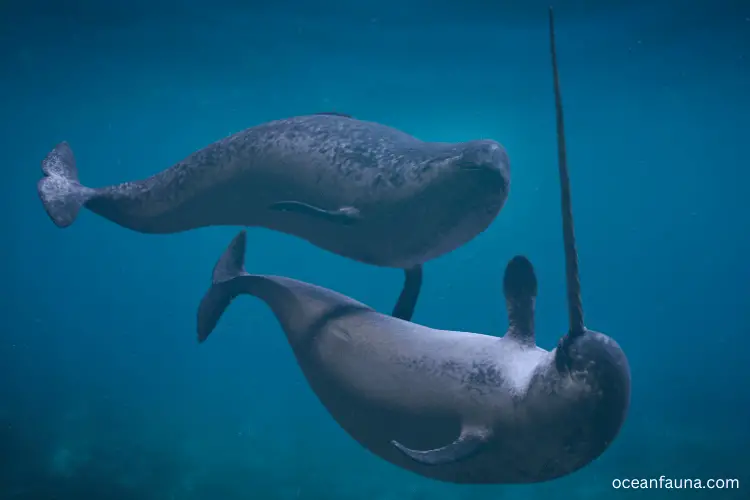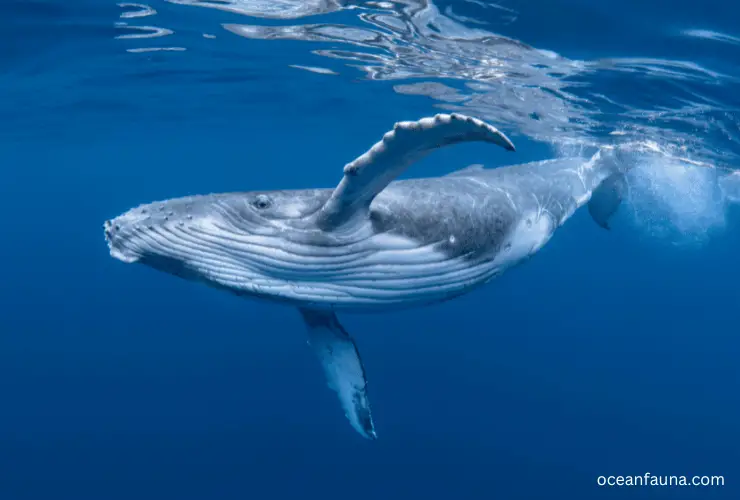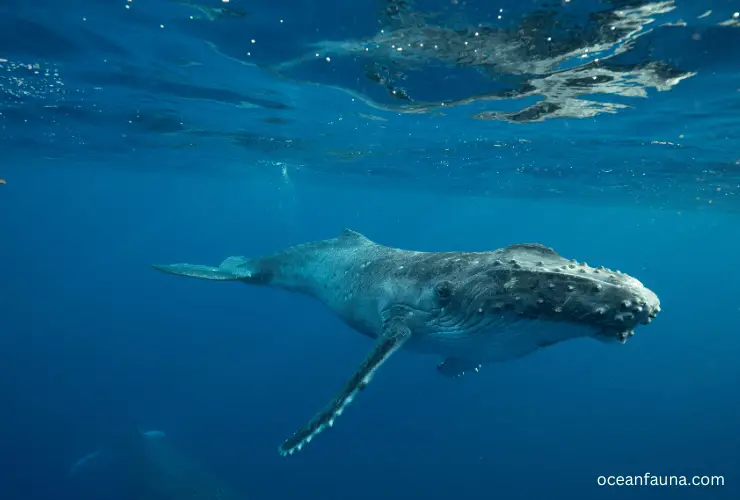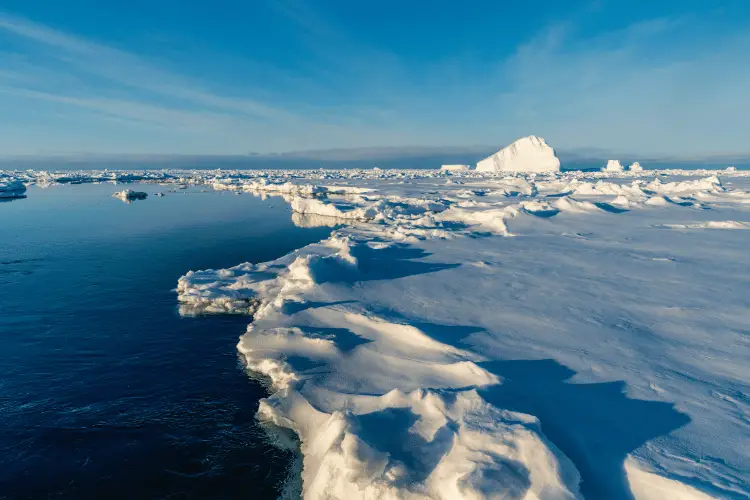Whales are warm-blooded marine mammals. However, do whales live in the Arctic? Can they endure the extreme cold waters of approximately −1.8 °C (28.8 °F) in this frigid region?
Although the Arctic is home to only a few whale species, the arrival of summer heralds the return of migratory whales. These include the majestic humpback, fin, and minke whales. However, the belugas, bowheads, and narwhals gracefully inhabit the Arctic waters throughout the year.
In this blog, I will discuss in detail about these whales, including the features and adaptations that make them suited for life in the Arctic.
What Whales Live in the Arctic?
Only three whale species can live in the Arctic throughout the year. Let’s take a closer look at the whales that call the Arctic their home.
Beluga Whales

Beluga whales are known for their distinctive white coloration and are often referred to as the “canaries of the sea” due to their high-pitched vocalizations. These social creatures prefer to live in groups, or pods, of up to several hundred individuals. Their blubber layer provides insulation against the cold, while their flexible necks allow them to move freely beneath the ice.
Beluga whales also have a specialized sensory system that enables them to navigate dark, murky waters and locate prey.
Bowhead Whales

Bowhead whales are the longest-living mammals on the planet, with some individuals known to live for over 200 years. Another common name for this whale species is the Greenland Right whale. These massive creatures can grow up to 60 feet in length and possess a thick layer of blubber, which provides insulation against the frigid waters.
Bowhead whales also have an impressive stockpile of adaptations that allow them to thrive in the Arctic: their baleen plates enable them to filter small particles from the water, while their powerful flukes allow for efficient swimming and diving.
Narwhal Whales

Narwhals are perhaps best known for their long, spiraled tusks, which are elongated front teeth that can grow up to ten feet long. These social whales communally migrate to shallow, icy waters each year to mate and feed.
Narwhal whales possess specialized hemoglobin that allows them to store oxygen in their muscles and stay submerged for long periods of time. They also have a layer of blubber three times thicker than other whales, providing additional insulation against the Arctic chill.
[Note: Climate change due to global warming, the number of these whales is decreasing.]
Which Migratory Whales Are There in the Arctic?
Beluga, Bowhead, and Nar whales are the only species to inhabit the Arctic waters throughout the year. However, some other species migrate to the region in search of food during the summer months, increasing the diversity of whale life in this beautiful and mysterious environment. They are known as migratory arctic whales. Here are the details-
Humpback Whales
Humpback whales are known for their unique vocalizations, or “songs,” which can last up to 20 minutes. These mighty whales migrate to the Arctic each summer to feed on krill and plankton before returning to their warm-water breeding grounds.

Humpback whales possess several adaptations that allow them to thrive in the Arctic, including a layer of blubber that can measure up to a foot thick and long flippers that enable them to maneuver gracefully through the water.
Fin Whales
Fin whales are the second-largest animal on the planet, surpassed only by the blue whale. These streamlined creatures can reach speeds of up to 40 miles per hour, making them some of the fastest whales in the world.
Fin whales also possess a specialized sensory organ known as a thermocline, which allows them to detect changes in water temperature and locate prey. Their long, slender bodies are adapted for life in the Arctic, with a thick layer of blubber and elongated baleen plates that enable them to filter small food particles from the water.
Minke Whales
Minke whales are one of the smallest species of baleen whales, measuring up to 30 feet in length. These agile swimmers are known for their acrobatic displays and can often be seen breaching the water or slapping their tails on the surface.
Minke whales possess a highly sensitive hearing system that allows them to locate prey and communicate with other whales. They also have a streamlined body shape that enables them to move quickly through the water, making them efficient hunters in the icy Arctic environment.
Why Whales Are Moving to the Arctic?

Whales are known to inhabit the warmer waters of the world, where temperatures range from 10 to 25 degrees Celsius. However, as the water temperature continues to rise, some whales are making a remarkable change in their habitat.
Certain whale species like beluga, nar, and bowhead whales have established a permanent presence in the Arctic region. However, during the summer, other whales, such as humpback, fin, and minke whales, migrate to this area. They venture into the Arctic for abundant food sources and a more suitable habitat. Scientists suggest that this change in migration patterns is a direct consequence of rising ocean temperatures.
The Arctic has warmed alarmingly, with temperatures rising four times faster than in other regions of the world since 1979. As a result, the sea ice extent in the Arctic has decreased by 13% per decade, causing a significant impact on the ecosystem of the region. This rise in temperature has created favourable conditions for the whales to move into the Arctic waters.
However, these whales were once significantly affected by commercial whaling in the 1800s and early 1900s, leading to a decimation of the whale populations found in the Pacific Arctic. Since then, efforts have been made to preserve these species of whales, with the bowhead whale being listed as endangered under the federal Endangered Species Act since the 1970s.
But, if the arctic water temperature rise continues, these migratory whale populations may be further threatened. Therefore, it is important to take steps to reduce global warming and protect the delicate Arctic environment. This will help ensure that future generations can continue enjoying these amazing creatures’ magnificent beauty in their natural habitats.
Where Does the Arctic Whale Live?

The Arctic whale, including beluga, bowhead, and narwhal, inhabit Arctic and subarctic waters that experience seasonal sea ice coverage. These waters are primarily located between 60° and 75° north latitude, including the Arctic Ocean and the northern parts of the Atlantic and Pacific Oceans. A cold and harsh environment, with long periods of darkness in the winter and continuous sunlight during the summer, characterizes the Arctic whale’s habitat.
The Arctic whale’s location is significant, as the animals are uniquely adapted to living in this extreme environment. Their ability to navigate through sea ice and find food in the cold waters requires specialized adaptations, such as developing thick blubber for insulation and specialized sensory organs for navigating through dark waters.
However, the Arctic whale’s habitat is increasingly threatened due to climate change and human activity, including oil and gas exploration and shipping. Conservation efforts are necessary to protect these magnificent creatures and their fragile Arctic ecosystem.
FAQs
What is the largest whale in the Arctic?
Bowhead whales are the largest whale species in the Arctic, with adults ranging from 50-60 feet long. They are also the longest-living mammal on Earth, with some individuals living for over 200 years.
Do blue whales live in the Arctic?
Blue whales are not found in the Arctic. They primarily inhabit the temperate and tropical waters of the world’s oceans, particularly the Pacific Ocean. These magnificent creatures can be found in all oceans except for the Arctic.
Conclusion
Now, you have a detailed understanding of all the whales living in the Arctic. Although only a few species of whales, including humpback, fin, and minke whales, migrate to the Arctic in search of food, permanent residents like bowhead, beluga, and narwhal whales are some of the most iconic animals found in this region.

